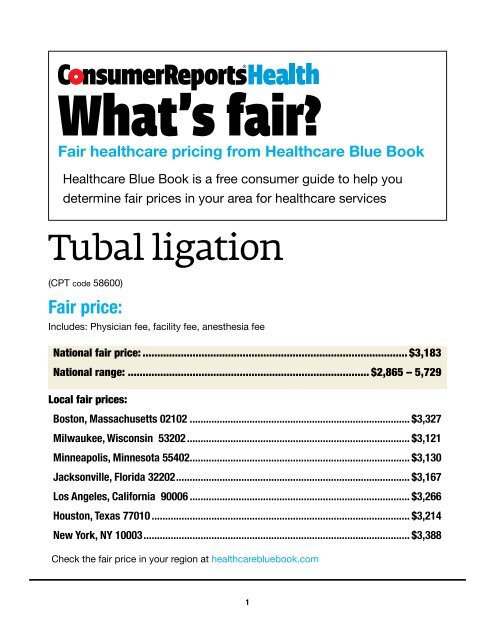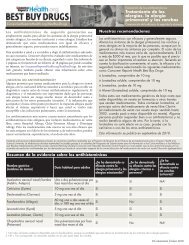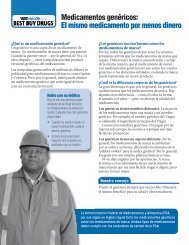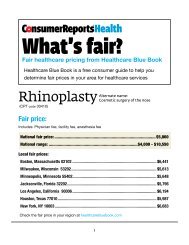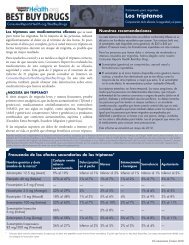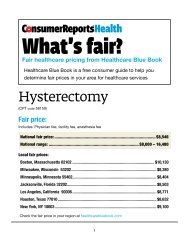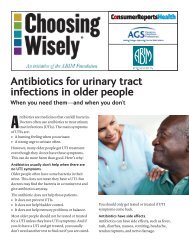Tubal Ligation (Healthcare Blue Book) - Consumer Health Choices
Tubal Ligation (Healthcare Blue Book) - Consumer Health Choices
Tubal Ligation (Healthcare Blue Book) - Consumer Health Choices
Create successful ePaper yourself
Turn your PDF publications into a flip-book with our unique Google optimized e-Paper software.
What’s fair?<br />
Fair healthcare pricing from <strong><strong>Health</strong>care</strong> <strong>Blue</strong> <strong>Book</strong><br />
<strong><strong>Health</strong>care</strong> <strong>Blue</strong> <strong>Book</strong> is a free consumer guide to help you<br />
determine fair prices in your area for healthcare services<br />
<strong>Tubal</strong> ligation<br />
(CPT code 58600)<br />
Fair price:<br />
Includes: Physician fee, facility fee, anesthesia fee<br />
National fair price:........................................................................................... $3,183<br />
National range: ................................................................................... $2,865 – 5,729<br />
Local fair prices:<br />
Boston, Massachusetts 02102.................................................................................. $3,327<br />
Milwaukee, Wisconsin 53202................................................................................... $3,121<br />
Minneapolis, Minnesota 55402................................................................................. $3,130<br />
Jacksonville, Florida 32202....................................................................................... $3,167<br />
Los Angeles, California 90006.................................................................................. $3,266<br />
Houston, Texas 77010................................................................................................ $3,214<br />
New York, NY 10003................................................................................................... $3,388<br />
Check the fair price in your region at healthcarebluebook.com<br />
1
What’s fair? <strong>Tubal</strong> ligation<br />
Details:<br />
How were these prices calculated and what are they based on?<br />
This is <strong><strong>Health</strong>care</strong> <strong>Blue</strong> <strong>Book</strong>’s recommended price for tubal ligation surgery.<br />
The fair price recommendation is based on the typical negotiated payment amount that<br />
providers accept from insurance companies.<br />
If you have insurance, you should be able to find in-network providers that accept<br />
prices at or below the <strong>Blue</strong> <strong>Book</strong> fair price, although many providers may charge more.<br />
How should consumers use this information?<br />
You can use the <strong>Blue</strong> <strong>Book</strong> fair price as a guide to help you compare prices when you<br />
shop for care and to make sure that you receive treatment at a fair price.<br />
If you have health insurance, you should use your provider directory to identify innetwork<br />
providers in your area. <strong>Tubal</strong> ligation is an obstetrical/gynecological (OBGYN)<br />
procedure and is typically performed by an OBGYN specialist.<br />
You can call the providers or your health insurance company to get a cost estimate.<br />
You will need to know the name of the procedure and possibly the Current Procedural<br />
Terminology (CPT) code for the service you need. It is also useful to have your insurance<br />
card available.<br />
Different in-network providers often charge different prices. Prices for tubal ligation may<br />
range from $3,000 to over $4,500 in many areas. We recommend that patients call several<br />
providers to find one that charges a fair price.<br />
If you do not have insurance, make sure to let the office know that you are a self-paying<br />
patient. Self-pay patients are frequently quoted the billed rate (or retail rate) for the<br />
service, which can be 2 to 3 times what the provider would accept from an insurance<br />
company. However, many providers will offer a discount to self pay patients – but you<br />
must remember to ask for the discount. Cash paying patients may also seek information<br />
from contraception clinics, such as Planned Parenthood.<br />
Key points to consider when shopping for tubal ligation.<br />
• Prices for this service frequently vary by almost 200% in many locations. Patients<br />
should call several providers to ask about the price before you have your procedure.<br />
• Make sure that the price estimate includes the physician fee, the facility fee and the<br />
anesthesia fee. You may need to call your physician, the facility and the anesthesia<br />
practice to get prices.<br />
2
What’s fair? <strong>Tubal</strong> ligation<br />
• If you get a price estimate that is significantly higher than the fair price, you may want<br />
to talk to your doctor about other facilities where you could have your procedure performed.<br />
Some doctors can perform the procedure at a free standing Ambulatory Surgery<br />
Center (ASC) rather than at a hospital. Receiving treatment at an independent<br />
ASC is typically less expensive than having the procedure at an outpatient facility<br />
affiliated with the hospital.<br />
If you have a <strong>Health</strong> Savings Account (HSA) or <strong>Health</strong> Reimbursement Account (HRA)<br />
you can apply those funds to any deductible, co-insurance or other out of pocket costs.<br />
Is tubal ligation typically covered by health insurance plans?<br />
Yes, tubal ligation is typically covered by health insurance plans. Always check with your<br />
insurer to make sure a procedure is covered before seeking treatment.<br />
Your insurer may require pre-certification prior to agreeing to cover your treatment. You<br />
should always ask and then confirm that your provider is going to obtain pre-certification<br />
before you receive treatment.<br />
If your provider does not obtain pre-certification prior to your tubal ligation, you will<br />
need to call the health plan and request pre-certification yourself. Always make sure that<br />
you have received pre-certified before receiving treatment. Insurers may deny payment<br />
of the claim if you have not obtained pre-certification.<br />
Is tubal ligation typically covered by Medicare or Medicaid plans?<br />
<strong>Tubal</strong> ligation is a non-covered service under Medicare.<br />
<strong>Tubal</strong> ligation is covered by most state Medicaid plans as a family planning benefit.<br />
However, patients should check their local state Medicaid web-site for coverage and<br />
conditions.<br />
What kind of out-of-pocket costs should I expect to pay?<br />
Your out of pocket costs will depend on the type of insurance that you have. You may<br />
be responsible for copays, deductibles or coinsurance amounts. In order to determine<br />
your out of pocket costs, always review your co-pay amounts, current deductible balance<br />
and current co-insurance obligation before seeking treatment. If you have questions<br />
about your benefit plan or out of pocket costs, talk to your insurance company.<br />
Remember, if you have a <strong>Health</strong> Savings Account (HSA) or <strong>Health</strong> Reimbursement Account<br />
(HRA) you can apply those funds to any deductible, co-insurance or other out of<br />
pocket costs.<br />
3
What’s fair? <strong>Tubal</strong> ligation<br />
Do the costs for this service vary depending on which provider I use?<br />
The price variation in most locations varies by almost 200% or more depending on where<br />
you get your care. Make sure to ask about the price of this service before you get your care<br />
to make sure that you will be charged a fair price. If you are not satisfied with a provider’s<br />
price, you can consider other providers that may offer you a more reasonable price.<br />
What other trends or variations in cost should I be aware of?<br />
There are a number of variants to the traditional tubal ligation related to the method of<br />
incision and the how the fallopian tubes are blocked. Patients should be sure to talk to<br />
their provider about different methods, and the impact those methods may have upon<br />
the cost of the procedure.<br />
What other tips can help me ensure I get the best price?<br />
The choice of facility for your tubal ligation will typically have the biggest impact on your<br />
total price. When seeking a provider, patients will want to make sure to ask if the provider<br />
can perform the procedure at an independent ambulatory surgery center (ASC). Independent<br />
ASCs are not affiliated with major hospitals, and generally charge less than hospital<br />
based outpatient facilities for equivalent or better quality care.<br />
Qualifications<br />
ASCs should be accredited by one of the major agencies, including the Accreditation Association<br />
for Ambulatory <strong>Health</strong> Care (AAAHC), American Association for Accreditation<br />
of Ambulatory Surgery Facilities (AAAASF) or the Joint Commission on Accreditation for<br />
<strong><strong>Health</strong>care</strong> Organizations (JCAHO).<br />
Obstetricians and gynecologists should be board certified by the American Board of Obstetrics<br />
and Gynecology.<br />
Alternatives<br />
There are a wide variety of contraception methods that can be used as an alternative to<br />
tubal ligation. Patients can discuss alternative forms of contraception with the physician<br />
Other concerns<br />
Patients should be aware that tubal ligation is considered a permanent procedure. Patients<br />
may at a later date want to reverse their permanent procedure. <strong>Tubal</strong> ligation reversals<br />
are not 100% effective in terms of enabling the patient to successfully have children.<br />
<strong>Tubal</strong> ligation reversal surgery is typically not covered by insurance and can cost anywhere<br />
from $6,000 to more than $10,000.<br />
4
What’s fair? <strong>Tubal</strong> ligation<br />
The pricing and benefits information reflected in this report is based upon the common pricing and practices found in most markets and<br />
may not reflect the specific pricing or health benefits available to you. Some providers charge amounts well in excess of the <strong>Blue</strong> <strong>Book</strong><br />
fair price. Some insurance plans cover services differently. If possible, you should check with your medical provider and health insurance<br />
company to confirm pricing and benefit coverage for services before you get care. In addition, you will want to check on your providers’<br />
quality information.<br />
<strong>Consumer</strong> Reports <strong>Health</strong> “What’s Fair?” reports should not be viewed as a substitute for a consultation with a medical or<br />
health professional.<br />
This report is intended solely for consumers’ personal, noncommercial use and may not be altered or modified in any way or used in<br />
advertising, for promotion, or for any other commercial purpose. Special permission is granted to organizations participating in the<br />
<strong>Consumer</strong> Reports consumer health communication program to disseminate free copies of this report in print or digital (PDF) formats to<br />
individual members and employees. Learn more at <strong>Consumer</strong><strong>Health</strong><strong>Choices</strong>.org or send an e-mail to <strong>Health</strong>Impact@cr.consumer.org.<br />
Cost data and content are used under license from <strong><strong>Health</strong>care</strong> <strong>Blue</strong> <strong>Book</strong>. Data current as of March 2012.<br />
Published by <strong>Consumer</strong> Reports © 2012 <strong>Consumer</strong>s Union of U.S., Inc., 101 Truman Ave.,Yonkers, NY 10703-1057.<br />
5


